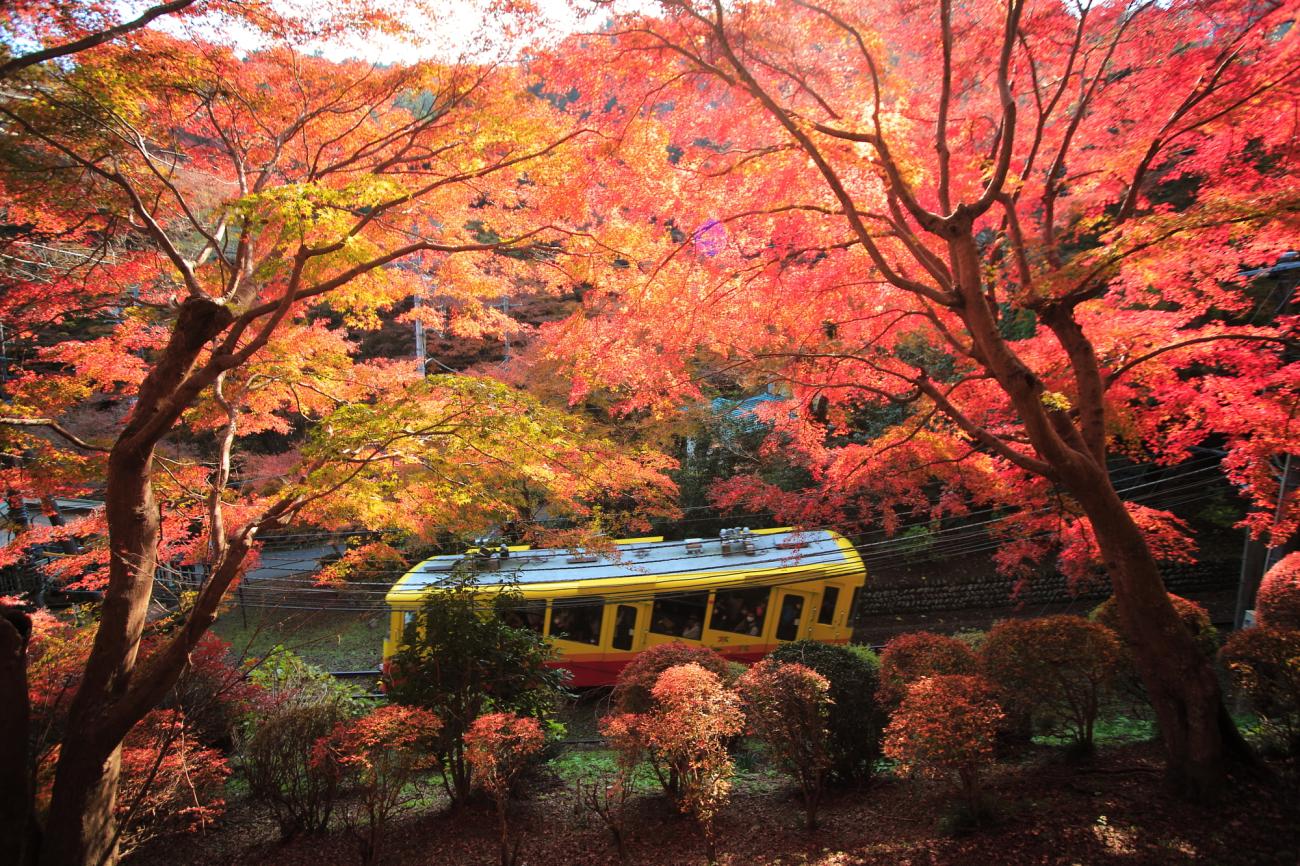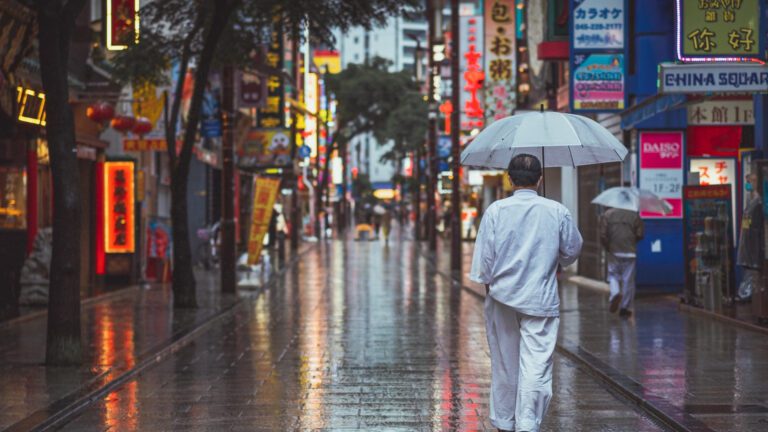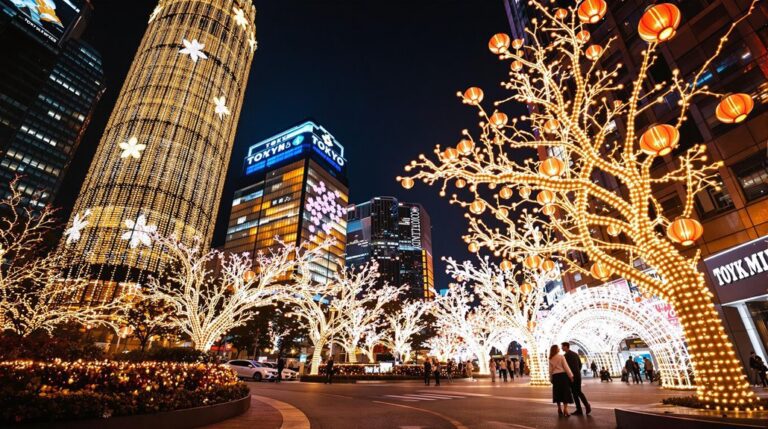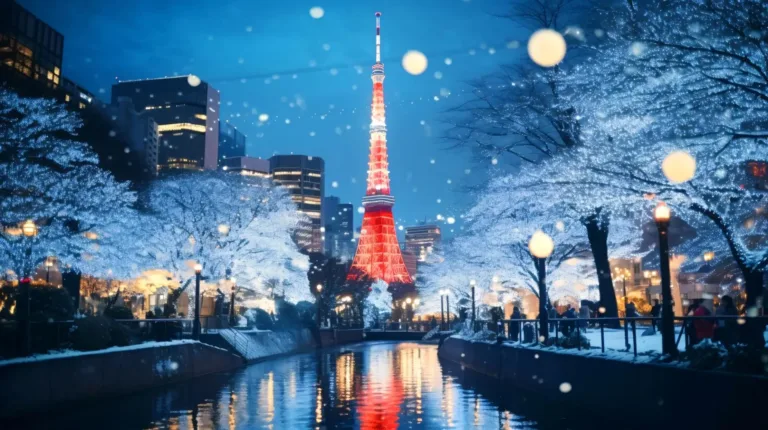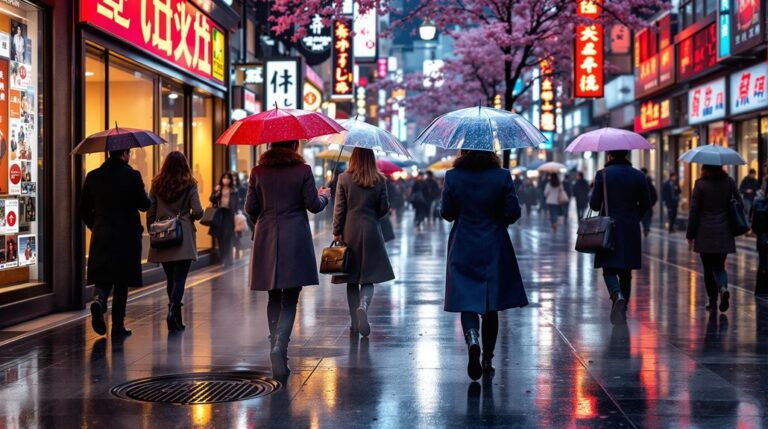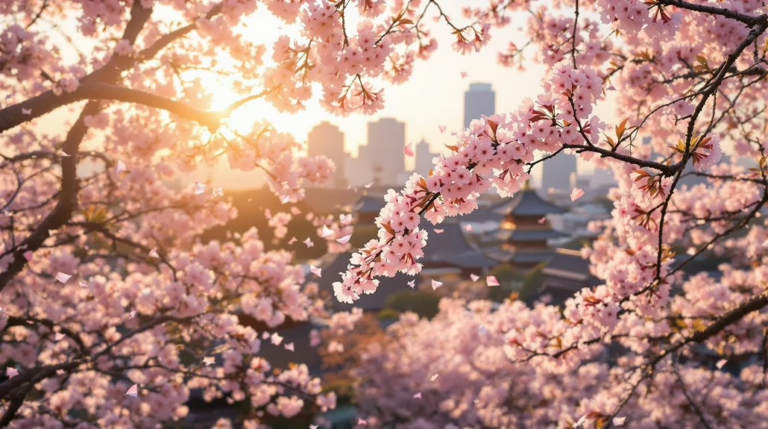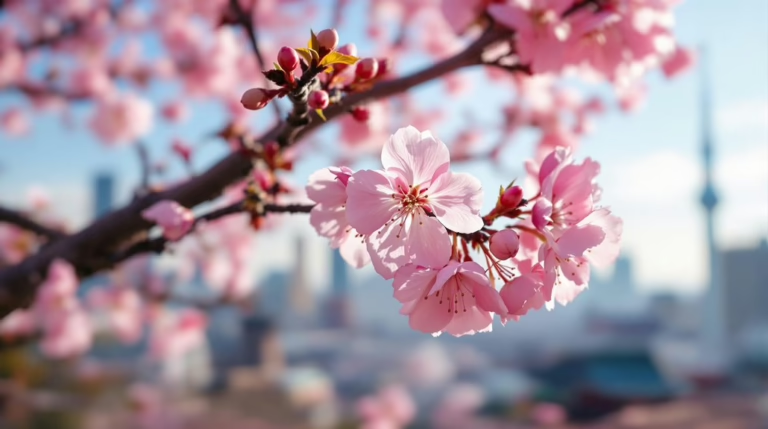11 Tokyo Autumn Foliage Spots & Viewing Tips
Where to See Autumn Leaves in Tokyo – When autumn sweeps through Tokyo, the city transforms into a living masterpiece—ginkgo trees blaze gold along Meiji Jingu Gaien and fiery maples ignite Shinjuku Gyoen.
Locals and visitors alike flock to serene gardens, bustling parks, and secret pockets where fallen leaves crunch beneath every step.
Want to catch those dazzling hues at their brightest?
Timing, local know-how, and a touch of patience are everything—let’s uncover the best spots and clever tricks for an unforgettable seasonal stroll.
Highlights
Hide- Visit Meiji Jingu Gaien for spectacular golden ginkgo avenues, typically peaking around November 26th.
- Explore Rikugien Garden for vibrant maple displays, with peak colors from late November to early December.
- Check local foliage trackers and weather forecasts to catch the leaves at their brightest.
- Plan flexible dates, as autumn color timing varies by year due to changing weather conditions.
- Arrive early in the day for fewer crowds and optimal photo opportunities at popular spots.
Understanding Tokyo Autumn Colors and Peak Foliage Timing
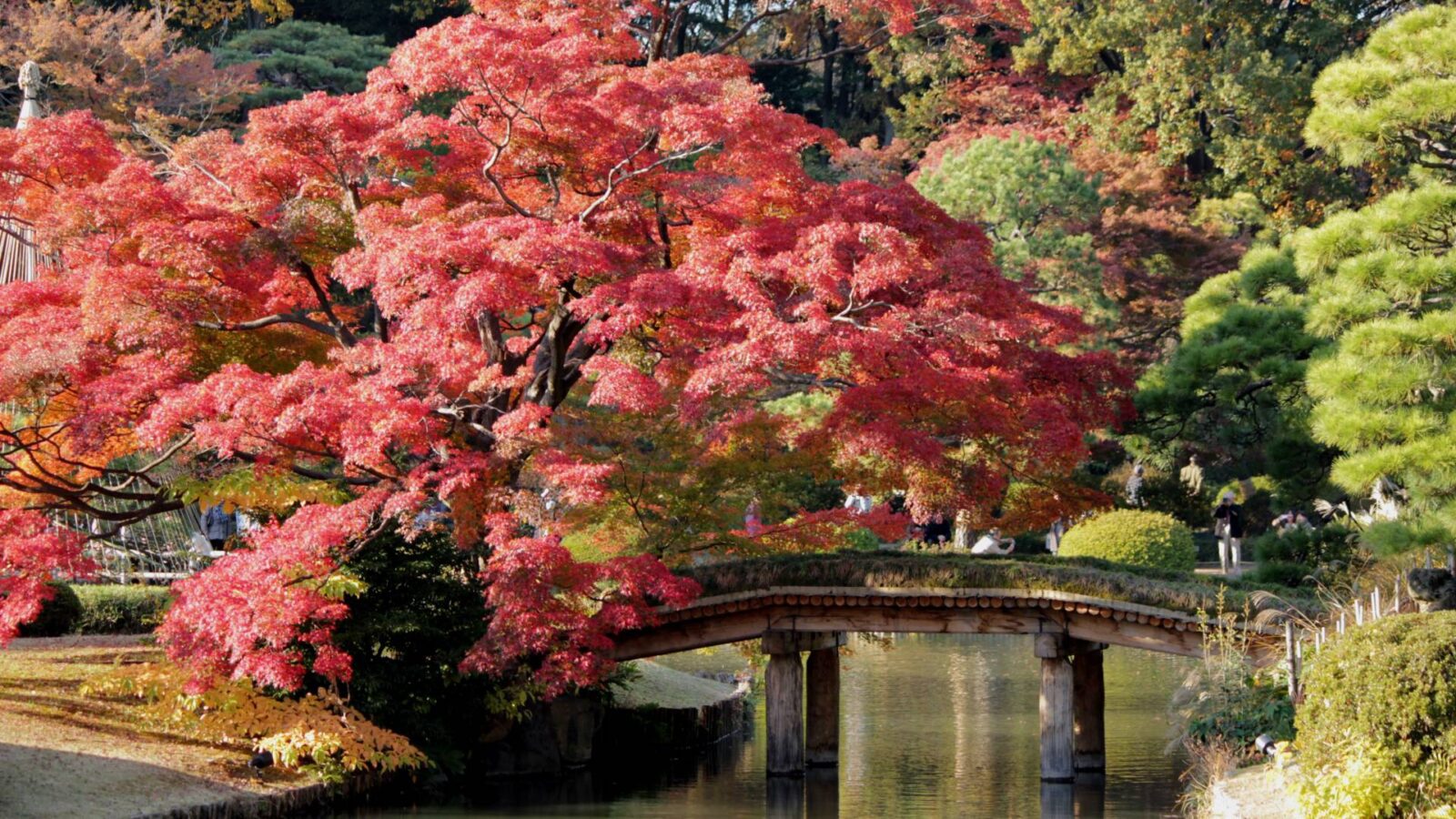
Anyone enthusiastic to catch Tokyo’s autumn leaves at their brightest should know that color changes don’t follow a strict calendar—they love to keep us guessing!
Historically, golden ginkgo and fiery maple trees have peaked from mid-November to early December, but even a warm or chilly spell can shift the timeline by a few days.
Comparing past years’ patterns, along with the latest forecasts, helps visitors time their outings for the most dazzling displays.
Comparing Historical Color Change Patterns
Tokyo’s autumn magic unfolds in layers, with golden ginkgo tunnels usually peaking a few days before the fiery reds of the maples.
Keeping an eye on local weather forecasts and updated foliage trackers is the secret weapon for catching each tree at its showiest.
For those who love a perfectly timed photo op, monitoring slight shifts in temperature and rainfall can make all the difference—nature’s calendar doesn’t always stick to the script!
Maple Versus Ginkgo Peak Dates
Curious about how Tokyo’s autumn palette unfolds? Ginkgo trees burst into gold around November 26th.
Meanwhile, maples ignite in fiery reds closer to December 1st—perfect for those craving freedom to wander as the city transforms.
The dance of fall in Tokyo means timing is everything; catch the ginkgo tunnels first, then chase the lively maples for the full, exhilarating Tokyo autumn experience!
Checking Local Weather Forecasts
While autumn in Tokyo dazzles with its kaleidoscope of fiery reds and golden yellows, pinpointing the exact moment those colors reach their vivid peak requires a savvy eye on the local weather forecast.
Tokyo in fall is a moving target—temperatures and rainfall can nudge peak foliage earlier or later each year.
For maximum freedom, check Kouyou Nabi or Koyo Walkerplus before heading out—timing is everything!
Meiji Jingu Gaien (Icho Namiki Avenue)
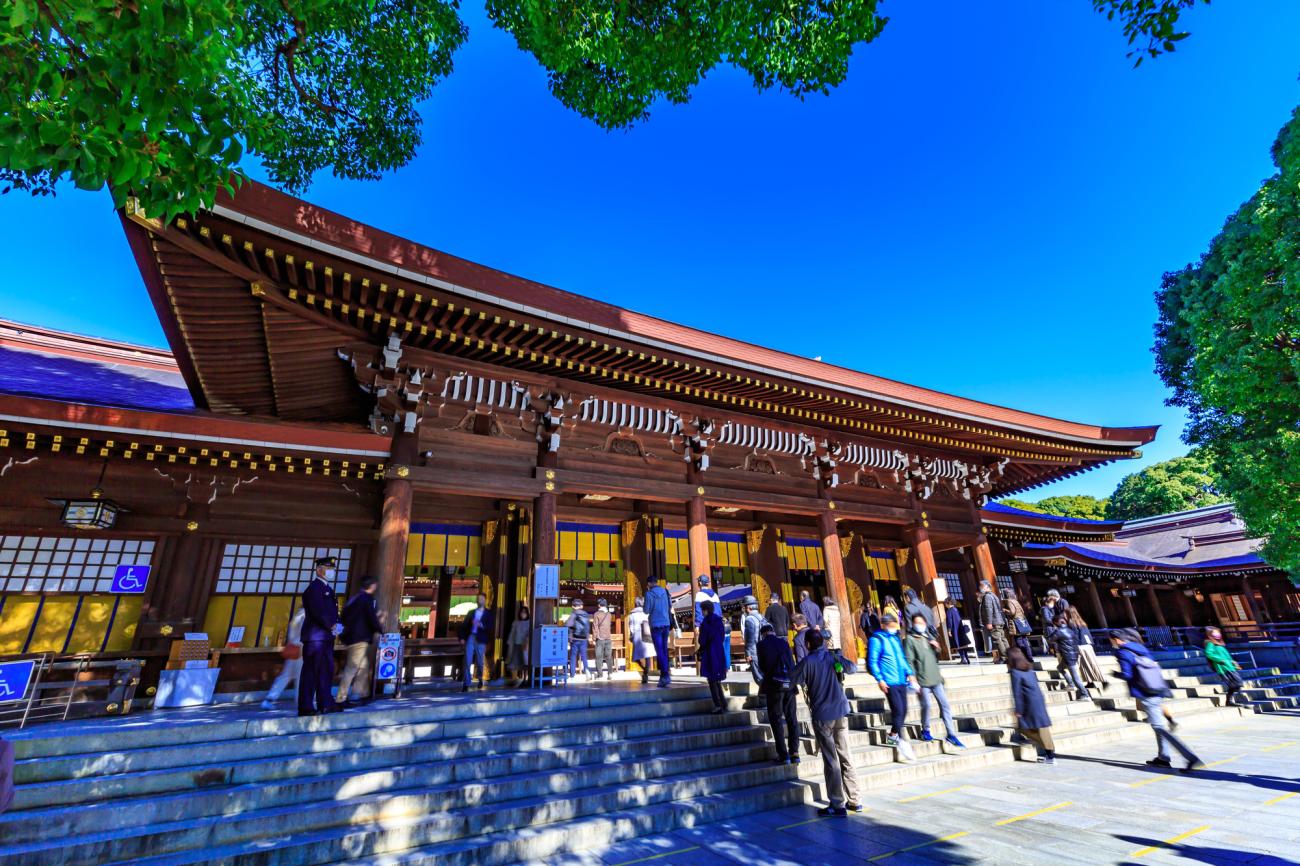
Meiji Jingu Gaien’s Icho Namiki Avenue is pure autumn magic, where a tunnel of golden ginkgo trees stretches dramatically overhead, creating an unforgettable photo spot and a crisp, leaf-strewn walkway.
Visitors can easily access this stunning avenue just steps from Aoyama-Itchome Station, making it a breeze to slip straight into a world of lively yellow.
Don’t forget your camera—this glittering corridor is one of Tokyo’s most iconic autumn spectacles!
Walking Through the Golden Ginkgo Tunnel
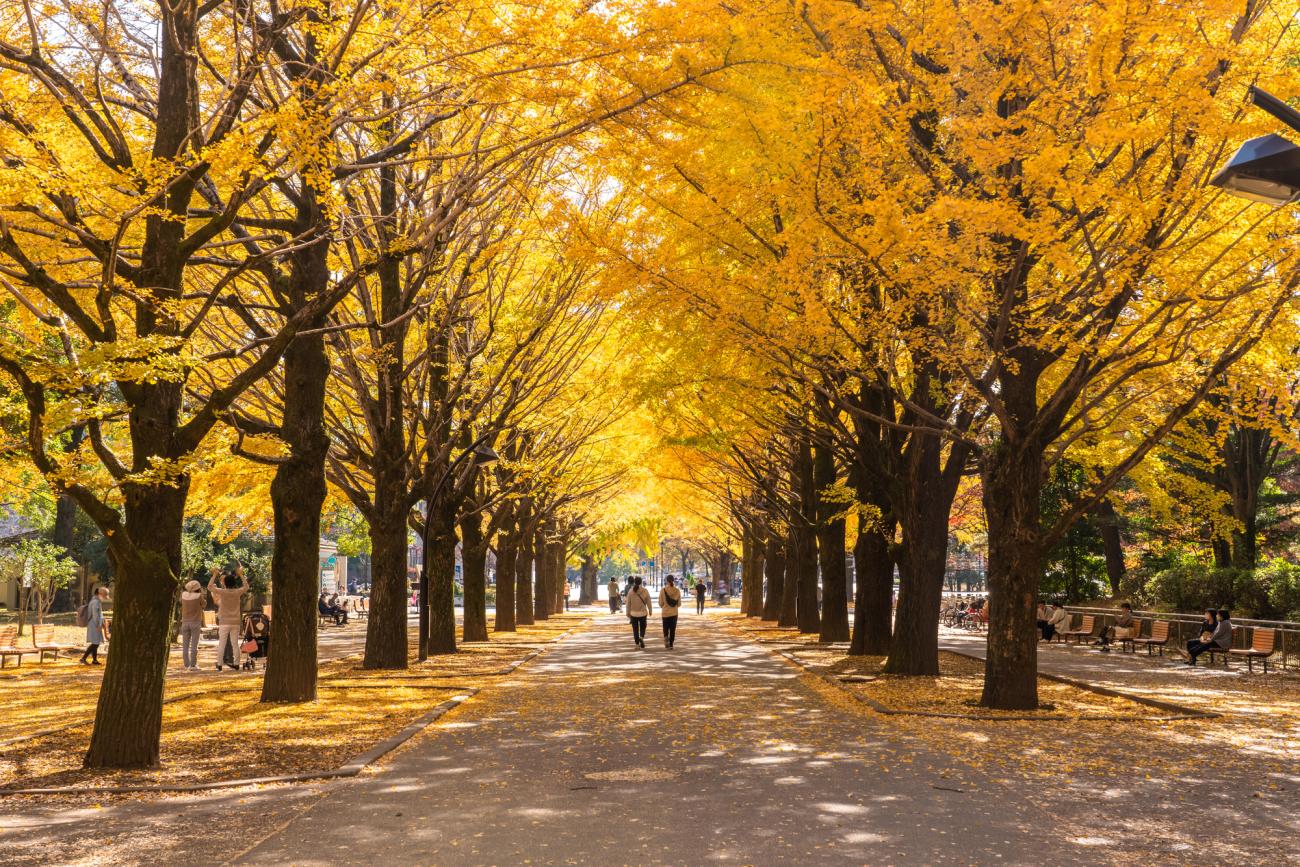
Meiji Jingu Gaien’s Icho Namiki Avenue is pure autumn magic, with over 150 towering ginkgo trees forming a glittering golden tunnel that stretches as far as the eye can see—perfect for a brisk stroll or an envy-inducing selfie.
By day, sunlight filters through the fan-shaped leaves, casting a warm, honeyed glow.
Come evening during the annual festival, the avenue transforms again, with enchanting illumination that makes every step feel cinematic.
Whether you’re a leaf-peeper or simply after Tokyo’s best seasonal photo op, this spot delivers unforgettable autumn vibes!
Daylight Views Beneath 150 Trees
As sunlight pours down on Icho Namiki Avenue, a breathtaking golden tunnel emerges—an autumn spectacle that Tokyoites wait all year to experience.
This is the heart of Tokyo fall foliage, where 150 ginkgo trees ignite the street in waves of lively yellow, creating peaceful beautiful fall scenery that feels almost surreal.
- Wander freely under a glowing leafy canopy
- Snap show-stopping photos
- Revel in crisp, invigorating air
Evening Illumination During the Festival
Once the sun dips below the city skyline, something almost magical happens—those famous ginkgo trees along Icho Namiki Avenue burst into radiant gold beneath carefully placed festival lights.
For anyone craving a taste of freedom, the night illumination transforms this stretch into a glowing tunnel, perfect for spontaneous strolls. During Tokyo fall, it’s a can’t-miss, camera-ready spectacle that feels both exhilarating and liberating!
Access From Aoyama-Itchome Station
Aoyama-Itchome Station is the go-to gateway for reaching Meiji Jingu Gaien’s iconic ginkgo avenue—just pop out of Exit 1 and you’re practically at the start of that golden tunnel!
The station connects three major lines (Ginza, Hanzomon, and Oedo), making transfers quick and painless for both locals and visitors.
Wide sidewalks, step-free routes, and clear signage guarantee accessibility for everyone, so no one has to miss those shimmering autumn leaves.
Nearest Exits and Transfer Options
Few spots in Tokyo capture the golden glow of autumn quite like Meiji Jingu Gaien’s Icho Namiki Avenue, and getting there is invigoratingly straightforward!
Step out at Aoyama-Itchome Station, where Exit 1A drops you directly onto your path of freedom and golden ginkgo trees—no labyrinthine transfers required.
- Use the Tokyo Metro Ginza, Hanzomon, or Toei Oedo lines
- Direct access from Exit 1A
- Effortlessly combine with a Ueno Park autumn stroll for ultimate Tokyo in the fall adventure
Accessibility for All Visitors
Exploring the golden corridor of Meiji Jingu Gaien’s Icho Namiki Avenue is revitalizingly simple, and it’s wonderfully accessible for everyone—no secret handshakes or staircases from a bygone era here!
Tokyo Trip Add-Ons
Equip yourself for the ultimate Tokyo adventure with the following add-ons, curated just for you.
Just step out of Aoyama-Itchome Station and you’re practically at the parks’ ginkgo-lined embrace.
Smooth, wide paths cater to wheelchairs and strollers alike, letting freedom-seekers of all stripes wander beneath the golden canopy with ease.
Shinjuku Gyoen National Garden
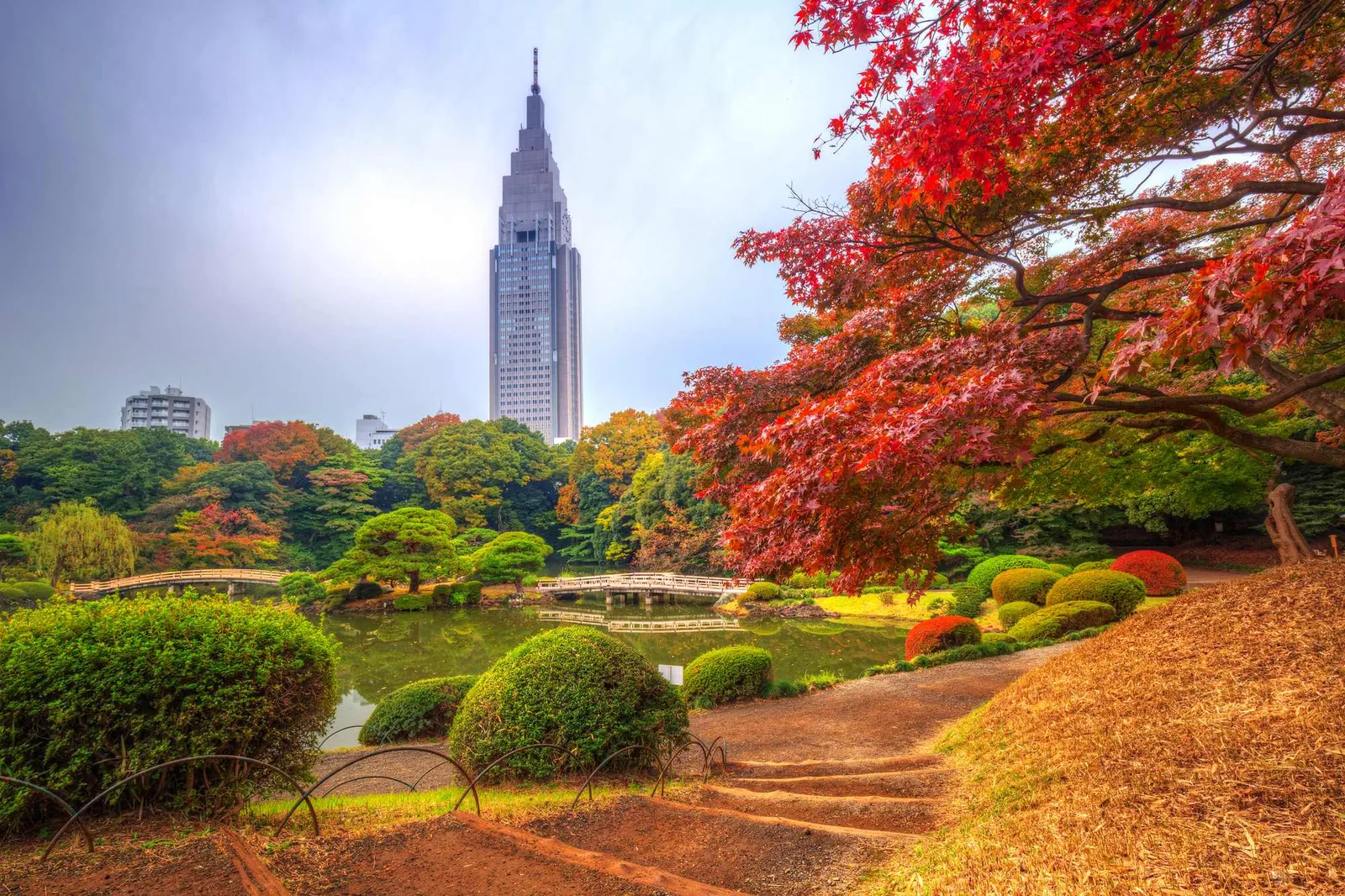
Shinjuku Gyoen National Garden dazzles visitors with its seamless blend of Japanese, French, and English landscapes. Winding paths lead from serene maple groves to manicured lawns and grand plane trees.
Entry is straightforward: tickets cost just ¥300 and can be purchased at multiple gates, making access a breeze even on busy weekends.
For the full effect, grab your camera, choose your favorite garden style, and get ready to stroll through a living tapestry of autumn color!
Exploring Japanese, French, and English Gardens
Shinjuku Gyoen National Garden is a treasure trove for autumn enthusiasts, especially in the Japanese section, where crimson maples burst into fiery brilliance along tranquil paths.
As dusk falls, the garden transforms—autumn light-up events set the landscape aglow, creating a magical atmosphere perfect for evening strolls and dreamy photos.
For anyone craving a blend of classic elegance and seasonal spectacle, this garden promises an unforgettable sensory adventure!
Red Maple Displays in the Japanese Section
While Tokyo dazzles with autumn colors citywide, few places capture the fiery spirit of the season quite like the Japanese section of Shinjuku Gyoen National Garden.
Here, bursts of Japanese foliage—especially the iconic japanese fall leaves—ignite every path in a kaleidoscope of red. For freedom-seekers, this is the spot to breathe deep and roam.
- Serene ponds mirroring blazing maple hues
- Winding trails beneath lively canopies
- Photogenic bridges for spontaneous snapshots
Autumn Light-Up Events After Dark
As twilight falls and the garden’s scarlet maples settle into dusk, the real magic begins—autumn light-up events transform Shinjuku Gyoen into an illuminated wonderland that feels almost otherworldly.
Stroll pathways aglow with lanterns, marvel at shimmering reflections in the French and English gardens, and snap envy-worthy photos!
If you’re searching “momiji near me,” this is Japan during fall at its most dazzling and liberating.
Navigating Entry Points and Tickets
Getting into Shinjuku Gyoen is a breeze, but choosing your entry—Main Gate or Shinjuku-gyoemmae Entrance—can shape your first impression of this leafy wonderland. Both gates welcome you with crisp air and dazzling foliage.
Yet the Main Gate tends to feel grander, while Shinjuku-gyoemmae is a popular shortcut from the subway. Admission is a steal at ¥300, so have your coins or IC card ready and get set for an autumn adventure!
Main Gate Versus Shinjuku-gyoemmae Entrance
Exploring Shinjuku Gyoen’s entrances can feel like opening secret doors to a botanical wonderland—especially when you know the difference between the Main Gate and the Shinjuku-gyoemmae Entrance!
Both offer unique vibes and strategic access points for autumn adventurers.
- The main gate: close to Shinjuku Station, ideal for first-timers
- Shinjuku-gyoemmae entrance: quieter, less crowded
- Each offers swift entry to magical leaf vistas
Seasonal Admission Fees
A visit to Shinjuku Gyoen during autumn’s fiery peak comes with a modest price tag—just ¥300 per adult grants entry to one of Tokyo’s most spectacular leaf displays! Seasonal admission fees remain pleasantly affordable, making spontaneous strolls entirely doable.
Grab autumn foliage tickets at any main gate—no need to pre-book. Revel in the freedom to wander among crimson maples and golden lawns, camera in hand!
Rikugien Garden
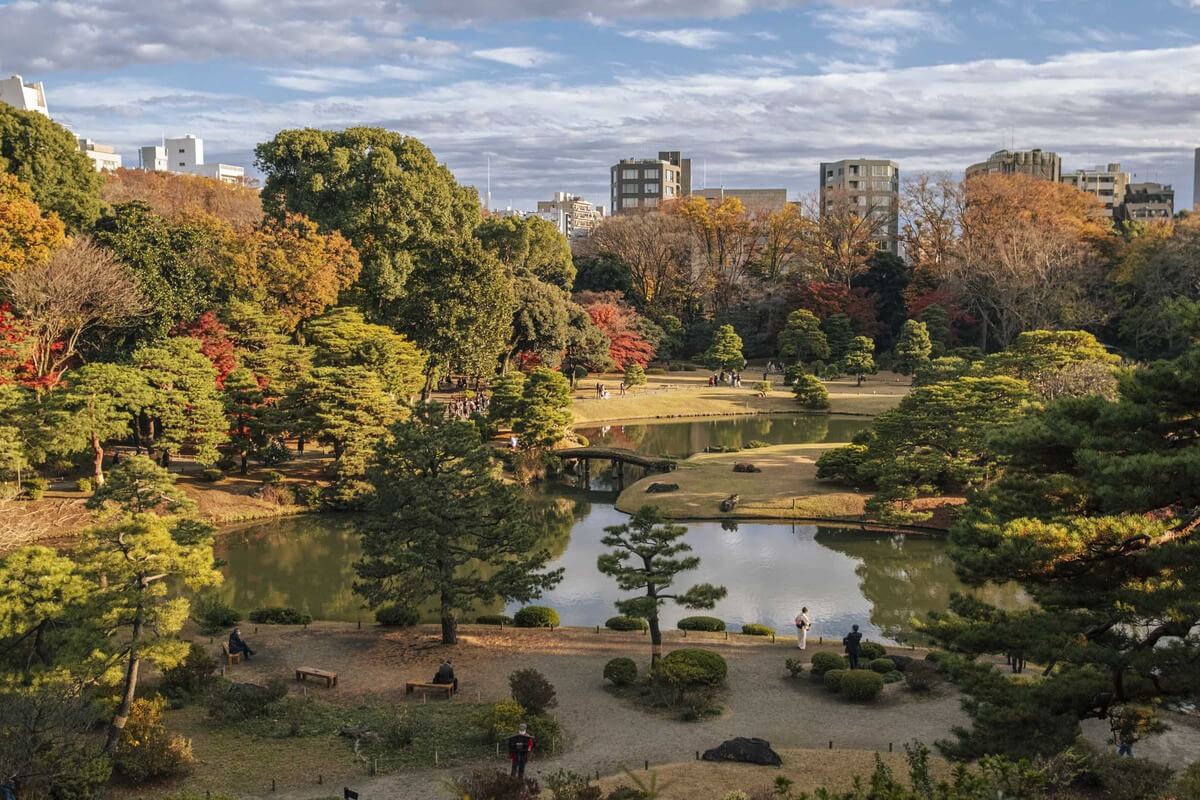
Rikugien Garden feels almost magical during autumn evenings, with glowing maples radiating lively reds and golds around the reflective central pond—bring your camera, because the views are pure poetry!
The garden’s winding paths create a gentle rhythm, guiding visitors past illuminated groves and serene bridges.
While smart route planning helps keep the flow comfortable even on busy nights.
For the best experience, stroll slowly, let the scenery unfold, and maybe treat yourself to a sweet snack from the teahouse as you go!
Admiring Glowing Maples by the Pond
Rikugien Garden is pure autumn magic, especially when glowing maples are mirrored in the tranquil pond near the teahouse—imagine sipping matcha with a front-row seat to a fiery symphony of reds and golds!
The teahouse overlooks a gentle waterfall, adding a soothing soundtrack to your leaf-watching experience.
Don’t miss the garden’s famed nighttime illumination, typically scheduled from late November to early December, when the trees are lit in dramatic hues that make every reflection feel almost surreal.
Teahouse Overlooking the Waterfall
Few autumn experiences in Tokyo rival sipping matcha at the teahouse overlooking the shimmering waterfall, as the pond in Rikugien Garden glows with reflections of fiery red maples. This tranquil spot is perfect for those who crave a sense of freedom and connection with nature.
It rivals the open energy of Ueno Park fall or the relaxed vibe of Yoyogi Park autumn.
- Escape city bustle with serene views
- Savor seasonal wagashi (Japanese sweets)
- Capture lively maple reflections in photos
Nighttime Illumination Schedule
Ever wondered how Tokyo’s autumn magic transforms after sunset?
At Rikugien Garden, the nighttime illumination schedule is pure enchantment—fiery maples, mirrored in the pond, seem to glow with every breath of wind.
Typically held from late November to early December, tickets sell fast; grab yours online.
Experiencing Japan in fall season beneath shimmering lights? It’s freedom, wonder, and beauty bundled into one unforgettable evening!
Path Layout and Visitor Flow
Rikugien’s path layout is a study in contrasts: the main trail sweeps visitors past postcard-perfect ponds and fiery maples, while secondary walkways snake through quieter corners for those seeking a peaceful leaf-viewing moment.
During peak hours, especially on weekends and evenings, crowds can bottleneck at scenic photo spots—so arriving early or exploring less-traveled routes can be your ticket to a more tranquil stroll.
If you want elbow room for that perfect autumn selfie, timing and route choice make all the difference!
Main Trail Versus Secondary Walkways
Although many visitors instinctively follow the main trail around the shimmering central pond at Rikugien Garden, those in-the-know find magic by darting down the quieter secondary walkways.
These hidden paths promise whimsical surprises—think secluded maple groves and lantern-lit nooks just begging for reflection.
Craving autonomy? Try these:
- Snap photos in near solitude under golden canopies
- Stumble upon secret stone bridges
- Savor tranquil air, far from crowds
Peak Hour Crowd Management
Those secret nooks may offer a breath of calm, but let’s face it—Rikugien’s stunning autumn spectacle draws crowds that can rival a festival at peak hour!
Clever visitors embrace the garden’s clever path layout, slipping into side trails or looping back to avoid bottlenecks.
Go early or late, dodge the weekend rush, and seize your freedom to wander—turning crowd chaos into an adventure!
Ueno Onshi Park
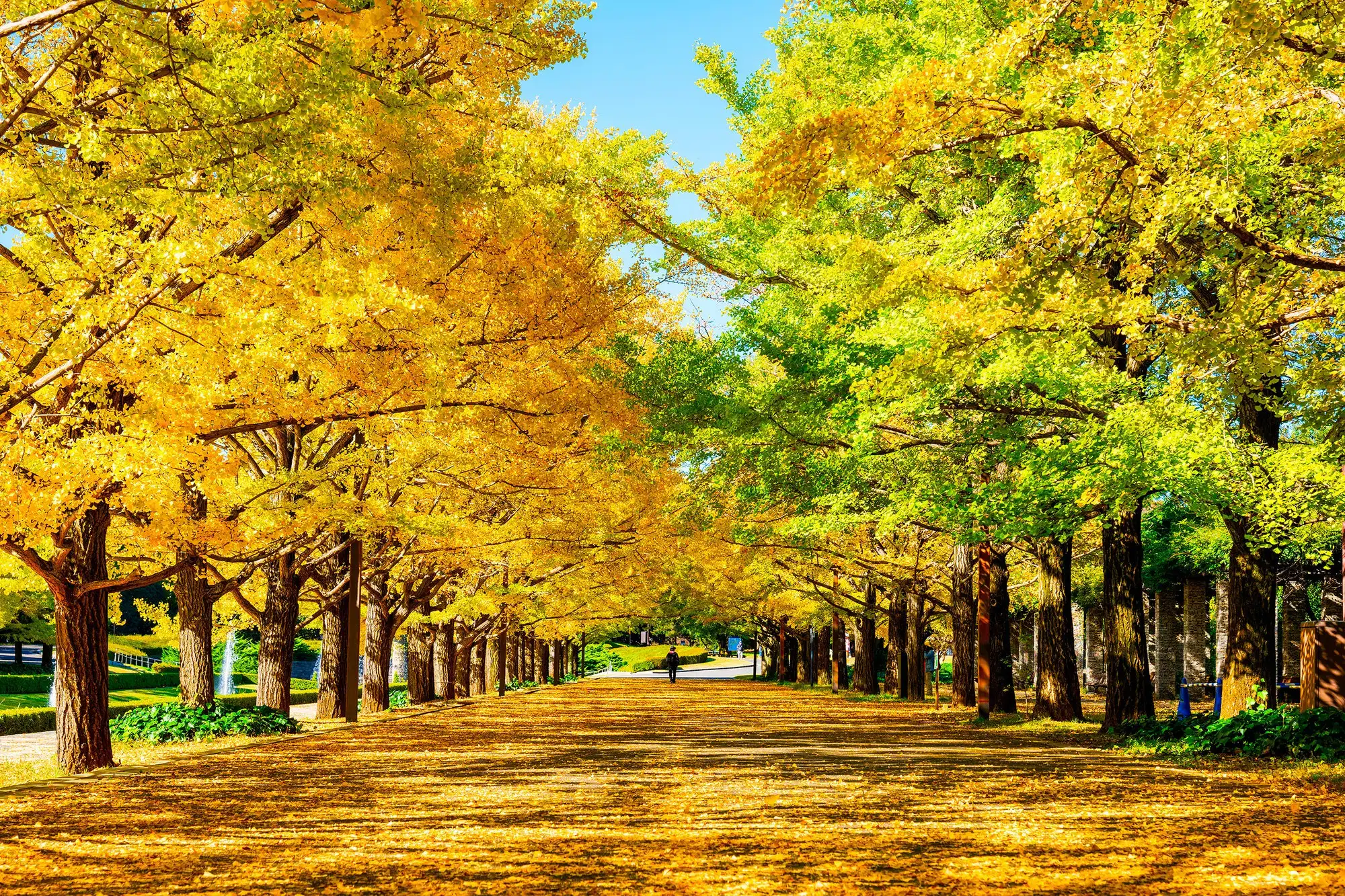
Ueno Onshi Park marries art, history, and autumn brilliance, offering tree-lined paths bursting with fiery maples and golden ginkgoes right alongside world-class museums and ancient temples.
Getting here is a breeze—simply hop off at Ueno Station, which is served by several JR and Tokyo Metro lines, so you can jump straight from the train into a kaleidoscope of color!
For an extra dash of charm, wander into nearby Yanaka for a taste of old Tokyo after your foliage stroll.
Mixing Culture with Colorful Avenues
Ueno Onshi Park brings Tokyo’s cultural treasures and autumn colors together in one unforgettable package—think world-class museums and centuries-old temples surrounded by fiery maples and radiant golden ginkgo trees.
Visitors can unroll a picnic blanket beneath the shimmering canopy, then wander over to explore art collections or pay respects at historic shrines, all within a single stroll.
It’s a rare chance to enjoy seasonal beauty while soaking up the city’s lively heritage—don’t forget your camera and maybe a thermos of hot tea!
Museums and Temples Amidst Fall Hues
Ever wondered where you can stroll beneath golden ginkgo leaves, then step inside world-class museums—all in a single afternoon? Ueno Onshi Park delivers that autumn magic.
Art aficionados and freedom-seekers alike revel in its mix of open-air splendor and cultural treasures. Temples, tranquil and timeless, offer quiet escapes right beside bustling galleries and leafy avenues.
- Tokyo National Museum’s samurai armor displays
- Tranquil Bentendo Temple on Shinobazu Pond
- Tokyo Metropolitan Art Museum’s rotating exhibitions
Picnicking Under Golden Ginkgo Trees
Who can resist the cheerful crunch of golden ginkgo leaves beneath their feet while the autumn sun paints everything in honeyed light?
Ueno Onshi Park turns into a picnic paradise—imagine spreading out your mat under dazzling yellow canopies, snacking on bento, and feeling truly untethered.
Culture lovers can detour to nearby museums, but here, freedom means laughter, leaf-pile competitions, and basking in the park’s radiant, sun-dappled avenues.
Transit Tips for Ueno Stations
Getting to Ueno Park for autumn leaf-viewing is invigoratingly simple: just hop off at JR Ueno Station or take the Tokyo Metro for maximum convenience!
For speedy access to those golden ginkgo and fiery maple paths, aim for the Park Exit from JR Ueno or the Exit 7 from the Tokyo Metro Ginza or Hibiya Lines—these put you right at the park’s leafy doorstep.
Travelers can easily follow the seasonal crowds or the alluring scent of roasted sweet potatoes wafting through the crisp air.
Using JR Ueno and Tokyo Metro Lines
For anyone plotting a smooth autumn adventure to Ueno Onshi Park, mastering Tokyo’s rail labyrinth is half the fun—and a savvy shortcut to more leaf-peeping time!
Both JR Ueno Station and the Tokyo Metro lines make accessing this lively oasis a breeze, empowering free spirits to tailor their journey and maximize those golden-hour strolls.
- JR Yamanote, Keihin-Tohoku, and Ginza/Hibiya Metro lines serve Ueno.
- Frequent, rapid connections from major Tokyo hubs.
- No need for a car—just swipe, hop, and go!
Exits Closest to Leaf-Viewing Zones
Once you’ve hopped off your train, pinpointing the right exit can mean the difference between wandering city sidewalks and strolling straight into a golden grove.
For Ueno Onshi Park, freedom-seekers should aim for JR Ueno Park Exit or Tokyo Metro’s Park Exit—both drop you right at the leafy entrance.
Skip the Central Exit unless you love urban detours; direct access means more time under those blazing maples!
Hamarikyu Gardens
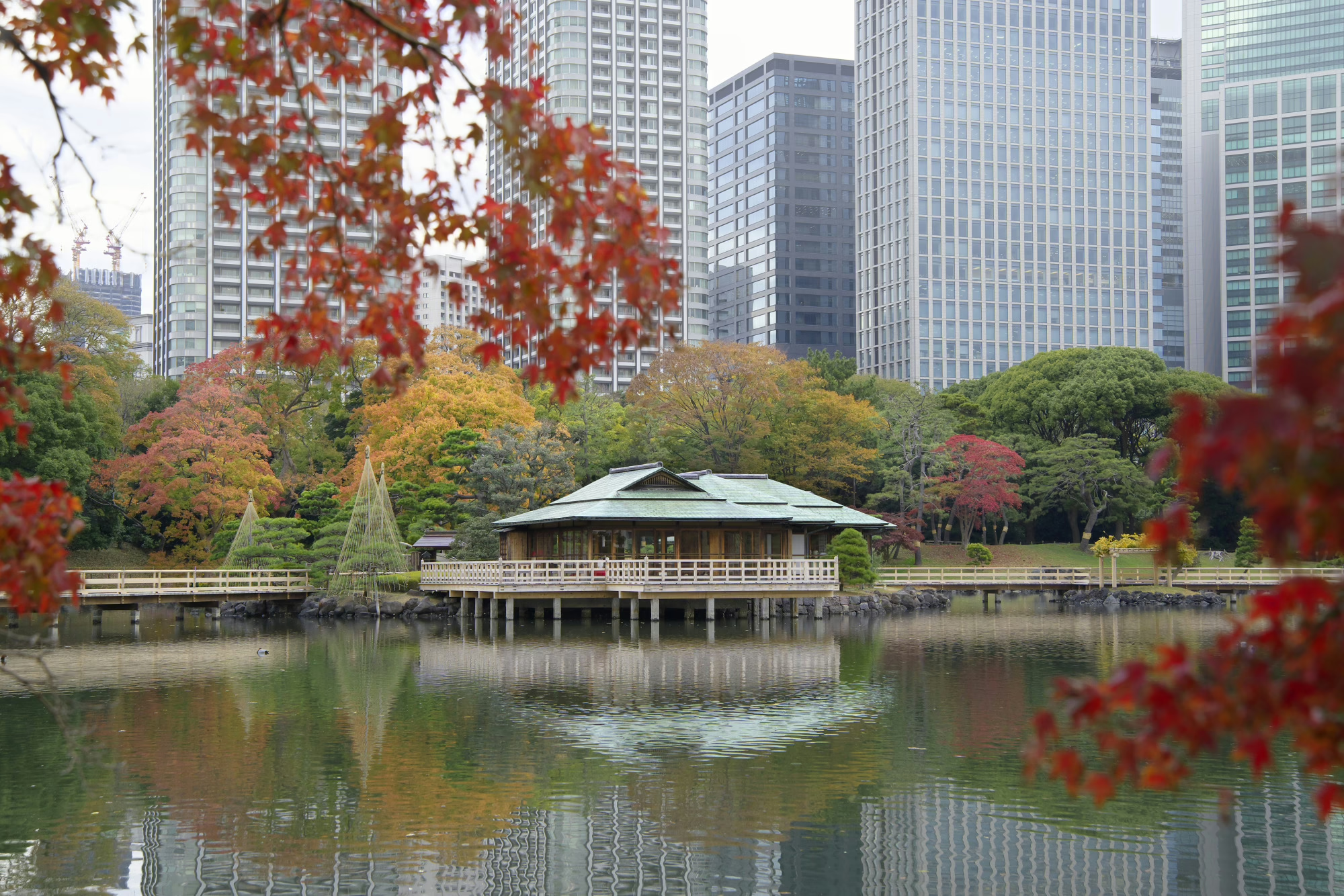
Hamarikyu Gardens offers a spectacular juxtaposition: golden ginkgo leaves and crimson maples frame striking skyscrapers, making it one of Tokyo’s most photogenic autumn escapes!
Visitors can stroll through manicured paths, then pause at the tranquil teahouse for matcha with a cityscape backdrop—pure magic whether you’re an avid photographer or just after some peace.
Admission is ¥300, with the gardens open daily from 9:00 AM to 5:00 PM (last entry 4:30 PM), so there’s plenty of time to soak in the seasonal colors before dusk.
Contrasting Autumn Leaves and City Skyline
Hamarikyu Gardens offers one of Tokyo’s most striking juxtapositions: golden maples and fiery ginkgo leaves set against a panorama of gleaming skyscrapers.
Visitors can savor matcha and wagashi at the Nakajima-tei Pavilion right on the pond—an unbeatable spot for both people-watching and leaf-gazing!
For a dash of adventure, hop on a boat ride from nearby Tsukiji Wharf and watch the city skyline shimmer behind brilliant autumn colors.
Tea Ceremony at Nakajima-tei Pavilion
Imagine this: you’re sipping frothy matcha in a centuries-old teahouse, framed by fiery maple foliage and the sleek, glassy towers of Tokyo’s skyline. Nakajima-tei Pavilion in Hamarikyu Gardens offers a peaceful escape, blending history, nature, and modernity.
The ritual feels timeless, yet utterly liberating.
- Authentic matcha and wagashi (Japanese sweets) served lakeside
- Panoramic autumn colors mirrored in tranquil water
- Striking skyline views—serenity meets urban energy
Boat Rides from Tsukiji Wharf
A boat ride from Tsukiji Wharf is a game-changer for anyone craving a fresh perspective on Tokyo’s autumn splendor. Glide along the Sumida River toward Hamarikyu Gardens, where fiery maples and golden ginkgoes pop against gleaming skyscrapers.
This journey offers a heady mix of serenity and urban energy—perfect for those who want freedom from the usual city stroll. Don’t forget your camera—this view is unforgettable!
Admission Details and Hours
Getting into Hamarikyu Gardens is a breeze—just stroll up to the gate and grab your ticket on the spot.
Keep an eye out for seasonal schedule tweaks, as opening hours sometimes shift to make the most of those golden autumn afternoons.
If you’re planning a visit, check the official website for any special changes so you don’t miss out on peak foliage magic!
Ticket Purchase at Gate
For those planning a crisp autumn stroll through Hamarikyu Gardens, buying your ticket right at the gate is a breeze! No apps, no advance reservations—just walk up, pay, and go.
This freedom-loving approach lets spontaneity reign and welcomes last-minute adventurers with open arms.
- Quick and hassle-free cash or IC card payment
- Multilingual signage for easy navigation
- Perfect for impromptu, whimsical outings
Seasonal Schedule Changes
Once tickets are in hand and anticipation is high, it’s time to check the clock—Hamarikyu Gardens keeps a seasonal rhythm all its own!
In autumn, the gates typically open from 9 a.m. to 5 p.m., with last entry at 4:30.
Hours may flex for special events or shorter winter days, so spontaneous explorers should always check the official website before setting out on their leafy adventures!
Yoyogi Park
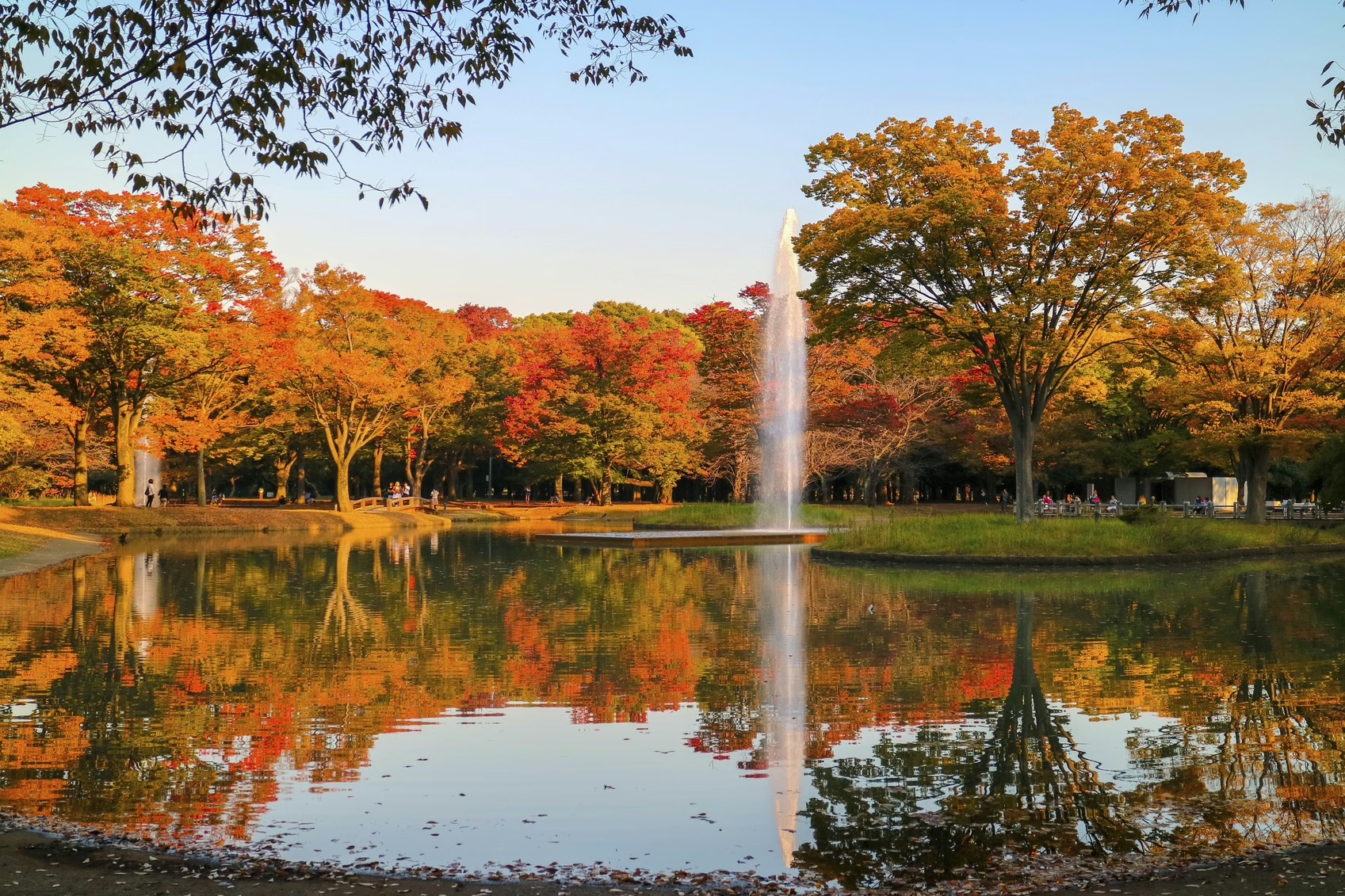
Yoyogi Park bursts to life in autumn, especially along its southern forest trails where golden ginkgo leaves and fiery maples create a striking, photo-worthy canopy.
For those keen to explore on two wheels, there are rental bicycles available near the main entrance and convenient parking spots dotted throughout the grounds—perfect for families or anyone who wants to cover more leafy territory without breaking a sweat.
Don’t forget to pause for a picnic or some people-watching; the park’s lively atmosphere makes it as much about the experience as the scenery!
Southern Forest Trails of Ginkgo and Maple
Yoyogi Park’s southern trails offer a peaceful woodland escape just steps from Harajuku’s energy, where golden ginkgo leaves and crimson maples create a painter’s palette underfoot.
Visitors can amble through these quiet groves, then easily stroll toward Shibuya for shopping, sweets, or people-watching—autumn’s magic follows you the whole way!
It’s the perfect route for those who want a tranquil break with the option to jump right back into Tokyo’s buzz.
Discovering Quiet Groves Near Harajuku
Tucked just a short stroll from Harajuku’s buzzing fashion scene, the southern forest trails of Yoyogi Park offer a tranquil escape that feels like stepping into a secret woodland right in the city’s heart.
Here, wanderers lose themselves under golden ginkgo canopies and scarlet maple leaves—no crowds, just freedom and crisp autumn air.
- Serene trails perfect for mindful strolls
- Sprawling lawns ideal for spontaneous picnics
- Dramatic leaf tunnels for photography lovers
Combining Park Walks with Shibuya Visits
While golden leaves crunch underfoot and the air hums with city excitement, one of Tokyo’s most seamless autumn experiences is pairing a Yoyogi Park stroll with a jaunt through Shibuya.
Wander Yoyogi’s southern trails, where ginkgo gold and maple red ignite the senses. Then, slip straight into Shibuya—grab a street snack, people-watch at the scramble, and let freedom define your autumn adventure!
Bicycle Rental and Parking Advice
Cycling through Yoyogi Park is a fantastic way to soak up the golden ginkgo tunnels and crisp autumn air—just be sure to stick to the designated bike paths for a safe, breezy ride.
Secure parking spots are conveniently located near the main entrances, so you can lock up your wheels and stroll worry-free among the leaves.
Don’t forget: weekends get busy, so arrive early if you want your pick of prime parking!
Safe Cycling Routes Through the Park
For those enthusiastic to savor Tokyo’s autumn colors on two wheels, Yoyogi Park is a cyclist’s dream come true! The park’s wide, tree-lined pathways and gentle curves invite visitors to explore at their own pace—no racing required.
Cyclists can weave through golden ginkgo groves or pause beneath fiery maples to soak in the view.
- Clearly marked cycling lanes
- Relaxed, family-friendly atmosphere
- Scenic loops for all skill levels
Secure Parking Locations
A savvy visitor knows that securing a trusty parking spot for your bicycle can make or break a day of autumn exploration in Yoyogi Park!
Look for designated bike parking areas near the Harajuku and Yoyogi entrances—they fill up quickly on weekends.
Rental bikes are available nearby, but bring your own lock for peace of mind.
Glide in, lock up, and you’re free to chase golden ginkgo leaves!
Koishikawa Korakuen Garden
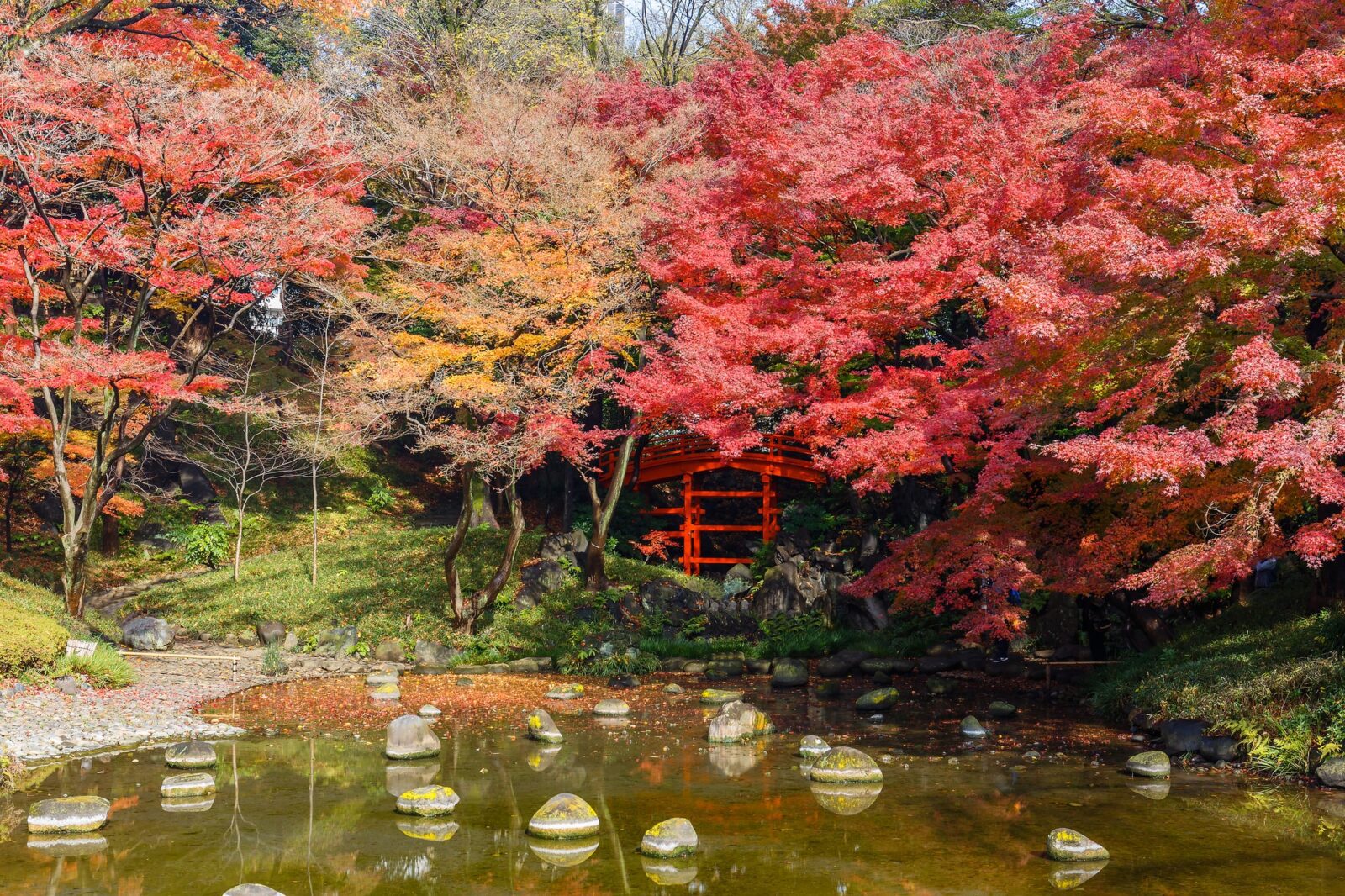
Koishikawa Korakuen Garden is a classic Tokyo gem. Its winding paths, arched bridges, and reflective ponds set the stage for a fiery display of autumn leaves.
Enter through the main gate near Iidabashi Station, and you’ll find helpful facilities, rest areas, and even a small teahouse for a cozy pit stop.
For those seeking a quintessential blend of tradition and seasonal color, this garden is a must-see on any fall itinerary!
Traditional Garden Features and Fall Colors
Koishikawa Korakuen Garden practically glows in autumn, with tranquil ponds mirroring fiery maples and golden ginkgo leaves—it’s like stepping into a living postcard!
Stroll along winding paths to spot rare tree varieties nestled among classic stone bridges and lanterns, each corner offering a fresh burst of color.
Nature lovers and photographers alike will find plenty to marvel at, so don’t forget your camera and a sense of wonder!
Serene Ponds Surrounded by Maples
Tucked away in the heart of Tokyo, one of the city’s most enchanting autumn escapes awaits: Koishikawa Korakuen Garden.
Here, fiery maples arch gracefully over tranquil ponds, their reflections painting the water in dazzling reds and golds.
It’s a haven for wanderers craving beauty and stillness!
- Meandering stone paths invite spontaneous exploration
- Ancient bridges arch over mirror-like ponds
- Maple leaves drift, creating mesmerizing natural mosaics
Viewing Rare Tree Specimens
Step into a living museum of trees where autumn feels downright magical! Koishikawa Korakuen Garden is a playground for leaf lovers, housing rare species like ancient ginkgo, towering metasequoia, and Japanese zelkova.
Marvel at lively colors while wandering over stone bridges and beside tranquil ponds. Here, freedom is an open path—explore at your own pace, camera ready, curiosity in full bloom!
Best Entry Points and Facilities
Visitors to Koishikawa Korakuen Garden have two main entry options: the grand Main Gate, perfect for a classic first impression, and the convenient Suidobashi Gate, which is a favorite shortcut for those coming from the station.
Each entrance shapes your stroll a bit differently—one welcomes you with stately serenity, while the other drops you right into the heart of the autumn action.
For comfort and ease, both gates offer ticket booths, restrooms, and clear signage, so you can focus on soaking up those spectacular fall colors!
Main Gate Versus Suidobashi Access
Ever wondered which entrance offers the smoothest start to your Koishikawa Korakuen Garden adventure? Both the Main Gate and Suidobashi Access have their perks, but each shapes your experience differently.
Enter through the Main Gate for a grand, traditional welcome, or opt for Suidobashi’s urban-side entrance for a more spontaneous vibe.
- Main Gate: iconic, closest to ticketing and garden maps
- Suidobashi Access: convenient for train arrivals
- Facilities: restrooms, lockers, and accessible paths nearby
East Gardens of the Imperial Palace
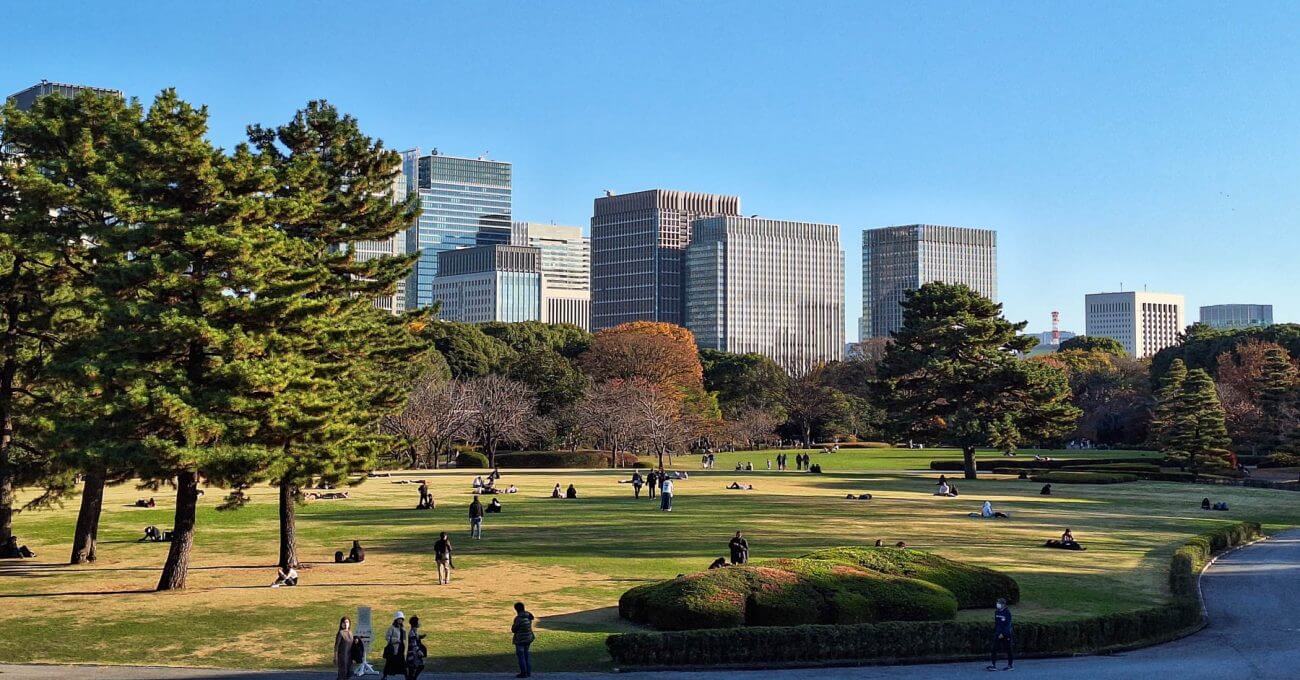
The East Gardens of the Imperial Palace offer a picturesque blend of historic trees and shimmering moat reflections, making autumn strolls here feel almost regal.
Visitors should note that security is tight and the gardens have specific opening times—so check the schedule before planning your leaf-spotting adventure!
With a little timing and patience, you’ll be rewarded with tranquil scenes and golden foliage just steps from Tokyo’s bustling center.
Historic Trees and Moat Reflections
In the East Gardens of the Imperial Palace, visitors can stroll across elegant stone bridges and pause at viewing islands, where centuries-old trees frame the mirrored surface of the surrounding moats.
During autumn, the gardens occasionally host seasonal festivals that bring extra color and charm, with lantern displays and cultural performances adding to the ambiance.
Don’t forget your camera—moat reflections and bursts of crimson maple leaves create postcard-worthy scenes at every turn!
Viewing Islands and Stone Bridges
While many flock to Tokyo’s famous parks, those craving a touch of history with their autumn leaf viewing should not miss the East Gardens of the Imperial Palace—especially the area around the viewing islands and elegant stone bridges.
Here, golden leaves mirror in tranquil moats, and ancient stone bridges invite exploration.
- Stroll the bridges for panoramic foliage views
- Capture fiery maples reflected perfectly in water
- Discover hidden corners whispering old Edo secrets
Seasonal Festival Highlights
Every autumn, East Gardens of the Imperial Palace transforms into a living tapestry, where centuries-old trees ignite in a riot of gold, crimson, and amber.
Festival-goers relish the mirrored brilliance of foliage in the ancient moat—picture-perfect for your feed!
Special guided walks spotlight historical trees, while local food stalls tempt with seasonal treats.
It’s a celebration where tradition and freedom meet, all in the heart of Tokyo.
Security and Opening Times
The East Gardens of the Imperial Palace welcome visitors free of charge, but entry does require a quick security screening—think of it as a royal invitation with a bag check!
Foreign guests need only show up with a smile; no advanced registration is necessary, though the gardens close on Mondays, Fridays, and select holidays, so check the schedule before planning your stroll.
Arrive early to savor the peaceful paths and avoid the disappointment of a locked gate!
Entry Requirements for Foreign Visitors
Imagine stepping into a tranquil oasis right in the heart of Tokyo—yes, that’s the East Gardens of the Imperial Palace! Foreign visitors enjoy free, walk-in access—no advance booking or ID required.
Security is present but unobtrusive, giving guests a sense of peace and autonomy. Entry is invigoratingly simple and liberating.
- No entry fee or reservation needed
- Security checks are quick
- Open to all nationalities
Holiday Closure Dates
Crisp autumn air and golden leaves might lure visitors to Tokyo’s East Gardens of the Imperial Palace, but don’t let excitement cloud your planning—these tranquil grounds do have set closure dates to keep in mind!
The gardens close on Mondays and Fridays, and during special holidays. Security is thorough, opening hours typically 9:00–16:30.
Always check ahead—freedom-loving explorers know spontaneity thrives best with a little foresight!
Hibiya Park
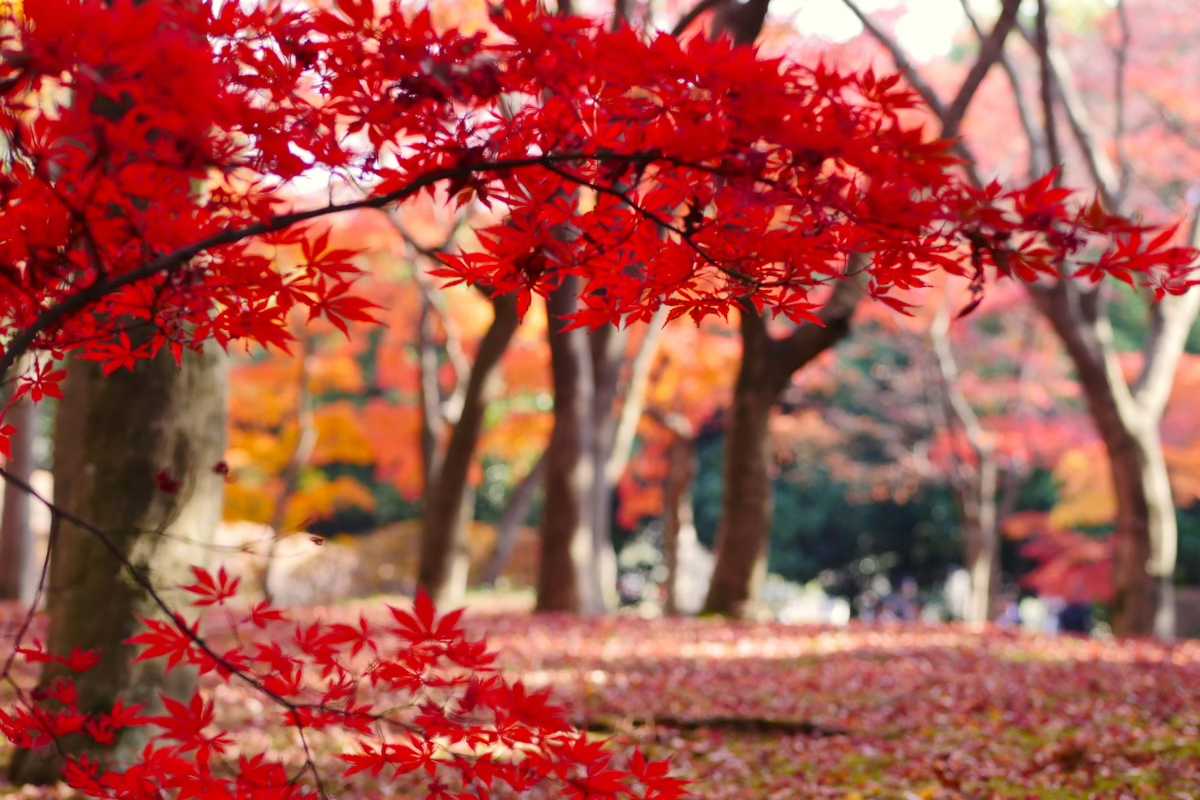
Hibiya Park charms visitors with its legendary “Risky Ginkgo,” a majestic golden giant that’s stood watch for over a century—don’t miss the photo op under its sweeping branches!
After basking in the autumn glow, hungry explorers will find a tempting array of cafés and restaurants just steps away, perfect for warming up with coffee or sampling seasonal treats.
With its relaxed city-center vibe and easy access to refreshment, Hibiya Park delivers both nature and nourishment in one unbeatable package.
Under the Ancient “Risky Ginkgo” Tree
Hibiya Park’s ancient “Risky Ginkgo” tree stands as a living legend, its golden leaves arching over winding paths that practically beg for a slow stroll and a few awe-filled photos.
Beneath this venerable canopy, visitors can wander past lively seasonal flower bed displays, where bursts of color provide a cheerful contrast to the sea of yellow above.
It’s a spot where history, nature, and a bit of Tokyo’s playful spirit mingle—don’t be surprised if you find yourself lingering longer than planned!
Walking Paths Beneath 400-Year-Old Foliage
Step off the bustling city streets and you’ll discover a living legend: the “Risky Ginkgo” tree, towering over Hibiya Park for more than four centuries. Wander these winding walking paths and you’re strolling beneath golden canopies that seem to whisper stories of old Edo.
The sense of liberation here is palpable—choose your own pace, direction, and destination!
- Unrestricted walking trails for spontaneous exploration
- Towering, ancient ginkgo leaves create a surreal golden tunnel
- Benches perfectly placed for moments of autumn reflection
Seasonal Flower Bed Displays
Just beyond the ancient ginkgo’s golden canopy, a riot of seasonal color bursts forth from meticulously arranged flower beds. Here, Hibiya Park’s gardeners release their creativity—think pansies, snapdragons, and ornamental cabbages in bold mosaics!
Snap lively photos or simply breathe in the fresh air. If you crave spontaneity, plop down on a nearby bench and soak up this living art—no tickets, no rules, just beauty.
Nearby Dining and Refreshment Spots
After wandering beneath Hibiya Park’s golden canopy, visitors will find plenty of tempting choices for a quick break or a leisurely bite. Charming park-side cafés offer aromatic coffee, light pastries, and cozy indoor seating—the perfect spot to recharge and people-watch.
During peak foliage season, keep an eye out for seasonal snack stalls serving up freshly roasted sweet potatoes and other autumn treats sure to warm chilly hands and lift spirits!
Café Recommendations for a Break
Whether your feet need a break from leaf-hunting or your senses crave an energy boost, the area around Hibiya Park offers a delightful selection of cafés and refreshment spots perfect for a cozy pause. Take your pick from tranquil hideaways or lively street-facing hangouts—freedom is yours!
Some favorites include:
- Hibiya Park Café: panoramic park views, open terrace
- Café de Crie: reliable coffee, ample seating
- Café Aaliya: famous for fluffy French toast
Seasonal Snack Stalls
A stroll around Hibiya Park in autumn isn’t complete without sampling the seasonal snack stalls that pop up like cheerful surprises along the park’s leafy paths.
Here, visitors can grab piping-hot yaki-imo (roasted sweet potatoes) or crunchy senbei rice crackers, both perfect for munching as you wander.
Feel free to follow the scent—these pop-up treats transform a simple walk into a delicious urban adventure!
Otaguro Park
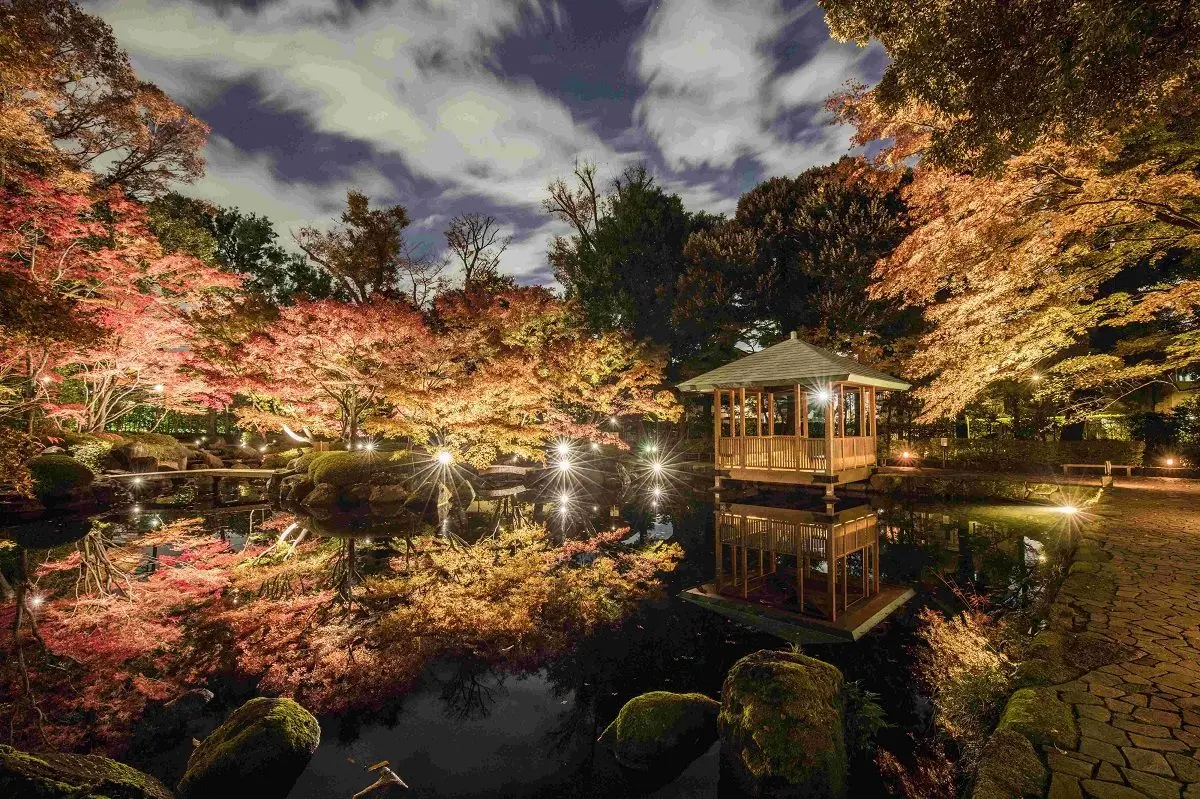
Otaguro Park charms visitors with its classic azumaya (Japanese gazebo) nestled among fiery maples and tranquil ponds—perfect for a contemplative stroll or snapping that envy-inducing autumn photo!
This pocket-sized garden packs a surprising punch, so keep an eye out for cozy corners ideal for quiet reflection or a quick bento break. While the park isn’t sprawling, its thoughtful layout guarantees every step feels like a serene escape from city life.
Strolling Through a Classic Azumaya Garden
Otaguro Park charms visitors with its century-old ginkgo and maple trees, turning the serene gardens into a golden wonderland each autumn.
As evening falls, night illumination events add a sprinkle of magic, making those ancient branches glow like lanterns against the crisp Tokyo sky.
Don’t forget your camera—this is one of those rare spots where every stroll feels like stepping into a living painting!
Century-Old Ginkgo and Maple Specimens
If one craves that perfect “step-back-in-time” moment, nothing beats strolling beneath the golden canopies of century-old ginkgo and maple trees in the tranquil embracetranquil embraceof Otaguro Park.
The park’s historic trees ignite a sense of wonder, inviting visitors to wander freely and soak up a timeless autumnal ambiance.
- Admire striking gold and crimson foliage overhead
- Pause beside classic azumaya garden pavilions
- Capture nostalgic, cinematic snapshots
Night Illumination Schedules
There’s nothing quite like the magic that sweeps through Otaguro Park during its highly anticipated night illumination events! Lanterns and subtle spotlights transform the classic azumaya garden into a glowing wonderland.
Where scarlet maples shimmer against tranquil ponds, creating a breathtaking scene. Typically held late November to early December, these ethereal evenings invite visitors to wander freely, camera in hand.
They can soak up both serenity and spectacle—no curfew on awe!
Small Garden Logistics
Otaguro Park’s enchanting autumn scenery comes with a catch: entry is controlled by limited time windows to preserve its peaceful charm. Visitors should nab reservations in advance, as these slots can fill up quickly—especially during peak foliage weeks!
If you want to stroll the maple-lined paths without a hitch, mark your calendar and set those reminders early.
Limited Entry Windows
A well-kept secret among Tokyo’s autumn aficionados, Otaguro Park dazzles with its fiery maple leaves and tranquil ponds—but its petite size means a bit of strategic planning is in order!
Entry is often regulated during the peak foliage period to preserve the serene vibe and prevent overcrowding. Flexibility and timely arrival are key for those who wish to bask in this exclusive autumn spectacle.
- Limited daily capacity—arrive early for best access
- Shorter opening hours during peak season
- Peaceful ambience thanks to entry controls
Advance Reservation Tips
Should you be aiming to snag a coveted spot amid Otaguro Park’s blazing maples this autumn, some clever advance planning will make all the difference!
Otaguro Park, small yet wildly popular during the peak foliage window, often requires timed-entry reservations via its official website.
Set a calendar reminder, then swoop in when bookings open—slots vanish fast!
Freedom seekers, rejoice: this means tranquil strolls with minimal crowds and maximum leaf-peeping bliss.
Todoroki Valley
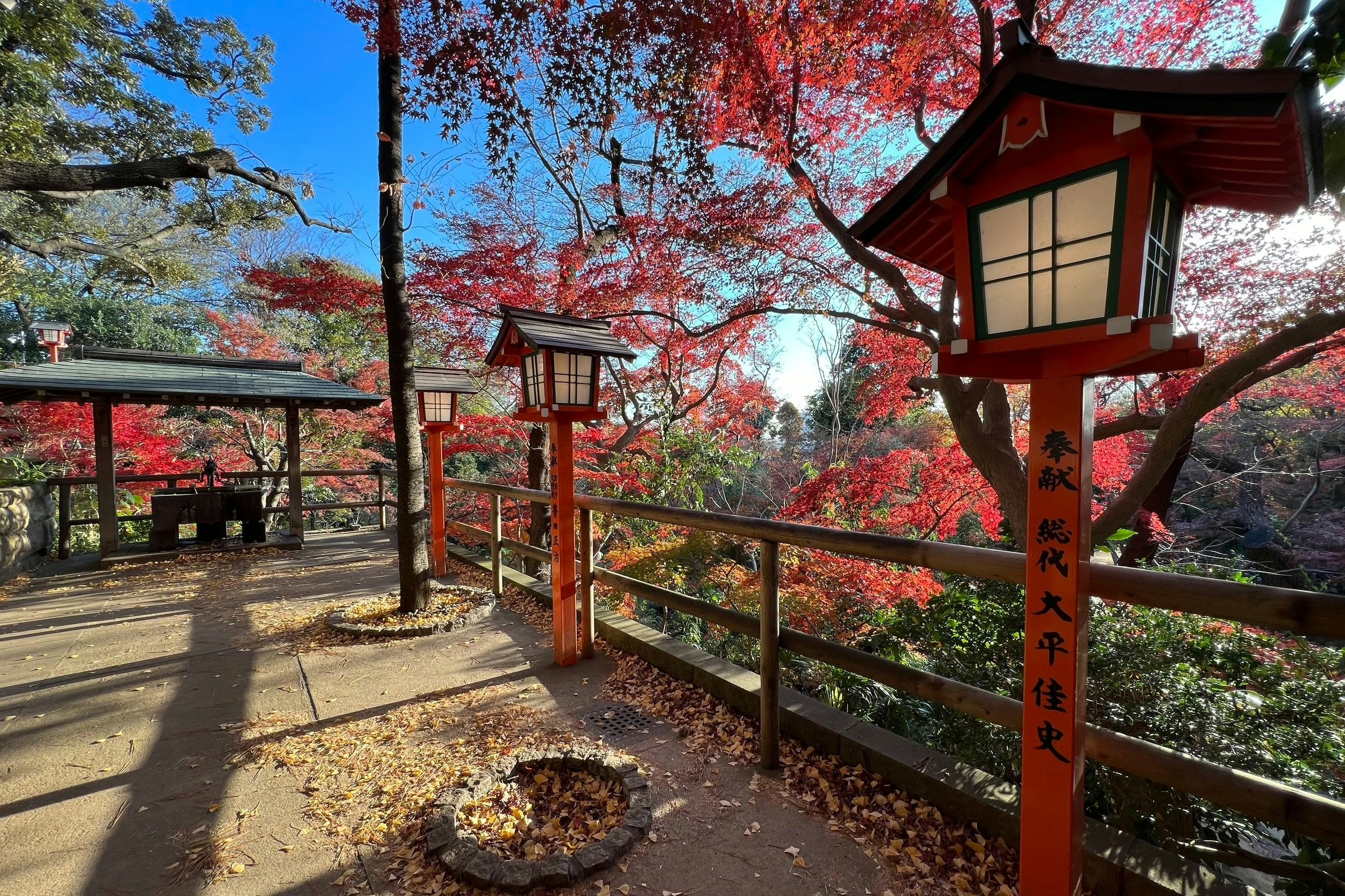
Todoroki Valley offers a lush riverside escape where golden ginkgo leaves and scarlet maples form a breathtaking canopy over the gentle stream—hard to believe it’s tucked within Tokyo’s city limits!
The main trail stretches just over a kilometer, making for an easy, leisurely stroll suitable for all ages. There are occasional stone steps and narrow pathways that add a hint of adventure.
Visitors can expect a peaceful, shaded walk surrounded by lively foliage and the soothing sounds of running water—a perfect spot for a quiet autumn recharge.
Riverside Walk Amid Autumn Trees
Todoroki Valley feels like Tokyo’s secret forest, where a riverside path winds past whispering trees, unexpected waterfalls, and even the serene Todoroki Fudoson Shrine tucked along the trail.
Explorers will find the sound of rushing water mingling with the crunch of fallen leaves, while a quick stop at the shrine offers a moment of calm amid the autumn spectacle.
It’s easy to forget you’re in the city—just follow the trail, keep an eye out for hidden cascades, and let curiosity lead the way!
Hidden Waterfalls Along the Trail
Even the most seasoned Tokyo explorer can be surprised by the secret beauty that lies just beyond the city’s concrete sprawl—especially when wandering the riverside path of Todoroki Valley.
Hidden waterfalls whisper from mossy alcoves, adding an invigorating soundtrack to fiery autumn leaves overhead. Step off the main path and let curiosity lead the way!
- Cool mist rising from shaded cascades
- Gentle rush of water over ancient stones
- Serene nooks perfect for quiet reflection
Local Shrine Visits En Route
Where better to savor Tokyo’s autumn magic than along a riverside path lined with ancient shrines and golden leaves?
As wanderers meander Todoroki Valley, the trail reveals tucked-away shrines like Todoroki Fudoson, where incense mingles with crisp air.
Pause for a moment of reflection or snap a photo—who says enlightenment can’t be scenic? Each shrine delivers a dash of culture amid nature’s fiery spectacle.
Trail Length and Difficulty
Todoroki Valley’s walking route is invigoratingly manageable, winding about one kilometer along flat riverside paths with a few forest steps that add just a hint of adventure. Most stretches are gentle and shaded, but sturdy shoes are still a must—think sneakers, not sandals, unless you enjoy slippery surprises!
Visitors can expect a leisurely stroll rather than a strenuous hike, making this spot a perfect choice for all ages enthusiastic to soak up autumn’s beauty.
Flat Paths Versus Forest Steps
Although Tokyo’s parks often conjure images of vast lawns or gentle city strolls, Todoroki Valley offers a invigorating twist—a wild, green gorge snaking through the urban sprawl.
Here, the path alternates between smooth, flat walkways and mossy stone steps, each section revealing fresh autumn vistas and new challenges.
- Meandering riverside walks for unhurried explorers
- Occasional forest stairs climb to hidden shrines
- Ever-changing scenery—never monotonous!
Recommended Footwear
Just as the mossy steps and winding riverside walks of Todoroki Valley promise adventure at every turn, the right footwear can make or break your leafy expedition. Sturdy sneakers or hiking shoes are essential—expect uneven stone paths, occasional slippery patches, and damp leaves underfoot.
Forget flimsy sandals! With proper shoes, you’ll roam freely, chasing golden ginkgo leaves and exploring every secret nook with confidence and comfort.
Tips for Autumn Leaf Viewing in Tokyo
Timing is everything when chasing Tokyo’s brilliant autumn colors, so keep an eye on peak forecasts and check the weather before heading out—no one enjoys soggy socks on a golden-leaf stroll!
Savvy leaf-peepers plan weekday visits, pack cozy layers, and snag advance tickets for magical night illuminations, where glowing canopies set the scene for stunning photos.
To capture the best memories (and the envy of your social feed), explore early mornings or less-traveled parks, where sunlight and crisp air make every shot sparkle.
Planning Around Peak Viewing Period
Timing is everything for autumn leaf viewing in Tokyo, so mark your calendar for mid-November to early December—the sweet spot when the city’s maples blaze red and ginkgo trees shimmer in gold.
Maple leaves typically reach their peak a little later than the ginkgos, so those aiming for the most dramatic display should plan accordingly.
Keep an eye on the forecast, and you’ll catch Tokyo’s parks at their most spectacular!
Mid-November to Early December Calendar
The heart of Tokyo’s autumn magic beats loudest from mid-November to early December, when the city’s parks and gardens transform into a lively patchwork of fiery reds and golden yellows.
This is prime time for spontaneous strolls, night illuminations, and kaleidoscopic snapshots.
- Check real-time foliage forecasts for daily color updates
- Visit iconic parks like Shinjuku Gyoen or Rikugien
- Plan weekday adventures to dodge crowds
Differentiating Maple and Ginkgo Timelines
After plotting out those golden weeks on your calendar, the next savvy move is figuring out when to catch Tokyo’s maples and ginkgo trees at their absolute best.
Ginkgo trees start the show, glowing buttery yellow around late November, while fiery maples often peak just as December arrives.
Chase both if you crave variety! Check local forecasts, and stay nimble—you never know when the colors will surprise you.
Preparing for Autumn Weather
Tokyo’s autumn weather keeps everyone guessing—one moment crisp and sunny, the next a brisk breeze sweeps through those golden leaves!
Smart visitors layer up with sweaters, scarves, and a light jacket to stay comfy as temperatures shift throughout the day.
Keeping an eye on forecast updates from reliable sites means you’ll never be caught off guard by a sudden rain shower or chilly evening stroll.
Recommended Clothing Layers
Nothing dampens the excitement of autumn leaf hunting in Tokyo like shivering through a chilly afternoon or overheating under the noon sun! For true comfort and flexibility, smart layering is essential—Tokyo’s weather swings from brisk mornings to surprisingly warm afternoons.
Visitors enthusiastic to roam freely without wardrobe woes should consider:
- Lightweight long-sleeve base layer
- Cozy, packable sweater or fleece
- Windproof jacket (easily stashed in a backpack)
Monitoring Forecast Updates
A little secret to catching Tokyo’s autumn leaves at their absolute best? Stay glued to foliage forecast updates!
Colors shift fast, and freedom-loving explorers don’t want to miss those golden ginkgo tunnels or fiery maple canopies.
Reliable sites like Kouyou Nabi and Koyo Walkerplus post real-time changes—so check often, and pivot plans as needed. Flexibility is your ticket to peak color glory!
Avoiding Peak Crowds
For those keen to skip the crowds and soak up Tokyo’s autumn colors in peace, timing is everything—weekday mornings are your golden ticket! Popular parks like Shinjuku Gyoen feel almost magical before the rush.
Meanwhile, lesser-known gems such as Mizumoto Koen or Jindai-ji serve up stunning foliage minus the bustling foot traffic.
Smart planning means more space for you, your camera, and maybe even a spontaneous picnic under the lively leaves.
Weekday and Early Morning Visits
Savvy Tokyo explorers know that timing is everything—especially during the city’s dazzling autumn leaf season! Early birds and weekday adventurers dodge overwhelming crowds, savoring tranquil paths and crisp, golden mornings.
The air feels fresher, and photo ops abound before the masses arrive. For those craving space and spontaneity, this strategy *reveals* a sense of freedom.
- Enjoy empty walkways and peaceful scenery
- Capture unobstructed, lively photos
- Savor the crisp morning atmosphere
Choosing Less-Visited Parks
Once the city’s most iconic parks start buzzing with enthusiastic leaf-peepers, clever explorers seek out quieter corners—Tokyo’s lesser-known foliage gems.
Think Mizumoto Koen’s tranquil waters, Inokashira Park’s lakeside maples, or the historic serenity of Jindai-ji.
These spots offer breathing room, authentic local flavor, and fantastic photo ops without elbow-to-elbow crowds.
Craving true freedom? Skip the mainstream, revel in hidden beauty, and savor autumn’s magic!
Enjoying Nighttime Illuminations
Nighttime illuminations are a spectacular Tokyo tradition—think glowing maple canopies and shimmering ginkgo tunnels that transform familiar parks into enchanting wonderlands!
For a stress-free experience, booking tickets online for popular evening events like Rikugien’s light-up is a real game changer. Arriving just before the crowds gather not only means shorter lines but also lets visitors savor those first magical moments as the lights flicker on.
Booking Tickets for Evening Events
Few experiences capture the magic of Tokyo’s autumn like strolling under a canopy of glowing maple and ginkgo leaves, their colors amplified by artful nighttime illumination!
For those craving spontaneity, advanced booking is vital—tickets for evening events often sell out quickly.
Discover more freedom and avoid disappointment by remembering:
- Check official park websites for ticket links
- Reserve popular dates early
- Watch for special weekday discounts
Timing Arrivals to Avoid Queues
Securing tickets ahead of time is only half the battle—mastering your arrival time is the secret weapon for a smooth, magical evening under Tokyo’s glowing autumn canopy!
Arriving early, just before illumination starts, lets you breeze past crowds and snag prime viewing spots.
Prefer a late-night stroll? Arrive after the first rush—freedom seekers relish the quieter ambience, sparkling lights, and crisp autumn air!
Maximizing Photography Opportunities
Catching Tokyo’s autumn colors on camera is pure magic when you play with natural backdrops—think golden ginkgo tunnels or fiery maple lanes—while letting winding paths or ponds lead the viewer’s eye.
The golden hour bathes the foliage in a warm, flattering glow, making every snapshot feel like a postcard.
Experimenting with long exposures can turn nighttime illuminations into dreamy, painterly scenes.
Don’t hesitate to crouch low or find a quirky angle—sometimes the best shot means getting a little grass on your jeans!
Using Natural Backdrops and Leading Lines
While wandering Tokyo’s parks during autumn, one quickly discovers that the city’s natural backdrops and leading lines transform leaf-viewing into a photographer’s paradise.
Curving paths, ginkgo tunnels, and tranquil ponds guide the eye, making every shot dynamic and immersive.
Embrace the freedom to explore and frame the scene as you wish—Tokyo’s autumn is yours to capture.
- Seek out tree-lined avenues for dramatic vanishing points
- Use temples, bridges, and water reflections as stunning backgrounds
- Experiment with winding paths to draw viewers into your photos
Golden Hour and Long Exposure Techniques
As the sun begins its slow descent over Tokyo’s skyline, the city’s parks come alive with a golden glow that seems almost magical—photographers, this is your cue!
Capture maple canopies in Shinjuku Gyoen or ginkgo tunnels at Meiji Jingu Gaien during golden hour for rich, warm hues.
Experiment with long-exposure shots at illuminated Rikugien; flowing crowds and sparkling lights create dreamlike, unforgettable images.
Combining Leaf Viewing With Local Culture
Autumn in Tokyo isn’t just about the golden ginkgo leaves—why not match your foliage stroll with a cultural pit stop?
Many of the city’s parks sit right next to fascinating museums or centuries-old temples, so you can soak up both art and history with your seasonal scenery.
For an extra treat, don’t miss the chance to sample limited-edition sweets and hot drinks at park cafés—think maple-shaped pastries and warming yuzu tea, perfect for crisp afternoons!
Pairing Visits With Museums or Temples
Nothing elevates a leaf-viewing stroll like weaving in a dash of Tokyo’s rich culture—picture fiery maple trees framing ancient temple gates or golden ginkgo leaves carpeting the path to a world-class museum.
Pairing autumn foliage with iconic landmarks lets visitors soak up history, art, and serenity, all in one outing.
- Marvel at Ueno’s fall colors, then visit the Tokyo National Museum
- Wander Rikugien, then explore nearby temples
- Stroll Inokashira Park, then immerse yourself in the Ghibli Museum
Sampling Seasonal Treats at Park Cafés
Few pleasures rival the simple joy of warming your hands around a cup of rich, seasonal sweet potato latte after a brisk stroll beneath Tokyo’s golden ginkgo trees.
Park cafés tempt with chestnut pastries, kinako-dusted mochi, and crispy kabocha croquettes.
Savor these local treats at Shinjuku Gyoen or Rikugien’s teahouses—freedom tastes even sweeter with every bite!
Don’t skip the limited-edition autumn desserts.
Wrapping Up
Each autumn, Tokyo’s parks and gardens welcome over 10 million leaf-peepers, all chasing that perfect golden or crimson snapshot!
With timing as vital as your camera angle, staying alert for peak color updates truly pays off. So grab your scarf, charge your phone, and get ready to wander through living paintings—it’s an experience you’ll brag about for years.
Tokyo’s autumn foliage doesn’t just impress—it dazzles, delights, and delivers unforgettable memories.

